Razorback musk turtles are small aquatic turtles native to the south-central United States. They get their name from their glands that produce a foul-smelling secretion. They use these secretions to defend themselves when they feel frightened.
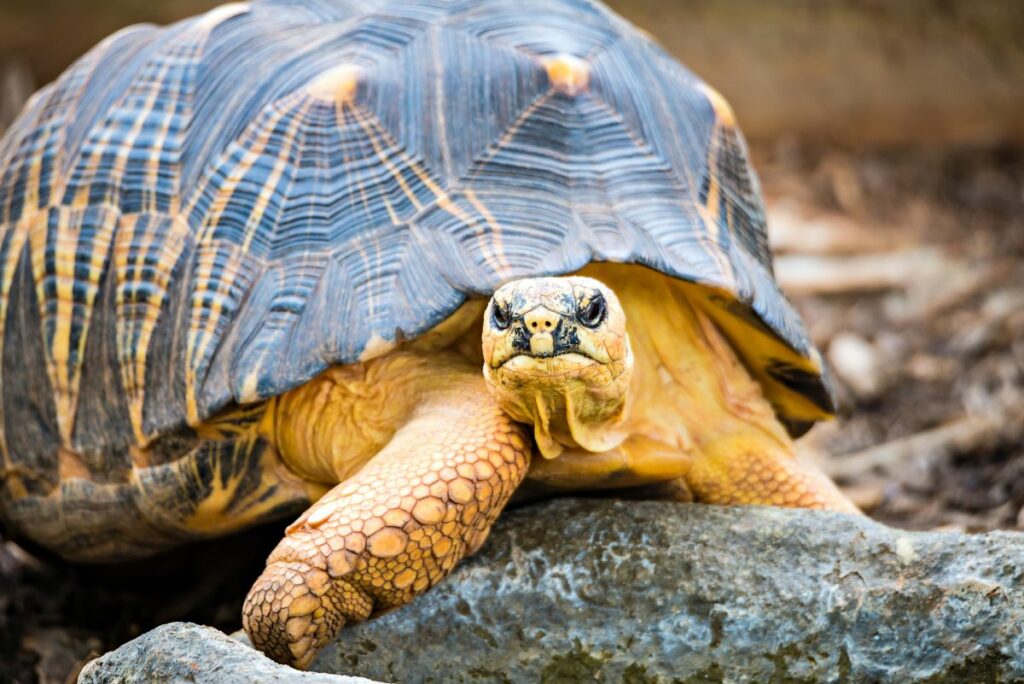
These turtles are colorful with unique stripping that fades as they age. They are small, but they have high-domed carapaces that allow them to stand out.
Despite being aquatic turtles, razorback musk turtles are poor swimmers. They live in areas with slow-flowing water. They don’t swim as much as other turtles, preferring to walk along the bottom of the substrate.
These turtles are omnivorous but mostly eat meaty foods. They are far more carnivorous in captivity than they are in the wild. They are not social and spend much of their time hiding and basking. They breed during the spring, producing clutches of one to seven eggs. Both the eggs and adults are at risk of predation from mammals and birds of prey.
According to the IUCN, razorback musk turtles are of “least concern.” Still, their populations face threats of the pet trade, fishing, and habitat degradation.
Razorback musk turtles are a hardy species. So, they are suitable for beginning turtle keepers. They need a smaller enclosure than other species but will be happy with lots of hiding places. As long as you keep their tank clean, feed them well, and watch out for health problems, you’ll do well with your turtle.
For a quick snapshot of razorback musk turtle care, check out the care guide we’ve prepared below.
What Is The Razorback Musk Turtle?
Razorback musk turtles are small, colorful reptiles. They live in the south-central United States.
The name “musk” comes from the unpleasant odor their secretions produce. Glands produce the secretions along the turtle’s bridge. The bridge is the area where the upper and lower shells meet. Researchers believe the foul-smelling secretions likely deter predators.
- Common Names: Razorback musk turtle
- Scientific Name: Sternotherus carinatus
- Origin: South-central United States
- Razorback Musk Turtle Size (Length): 4-4.6 in (10.2-11.7 cm)
- Lifespan: 20 years (captivity)
- Enclosure Size: 24 in (60 cm) long and 15 in (37.5 cm) wide
- Temperament: Shy & docile
- Ease of Care: Moderately easy
Characteristics
Their shells, or carapace, are light brown to orange. Their carapaces also have unique dark brown stripping across the surface. The stripes are more vibrant in younger turtles and begin to fade as the turtle ages. Some adult turtles may lose their dark lines altogether.
Their skin is colorful, ranging from pink to light brown and gray. Small dark spots break up the solid color of their skin.
The plastron, or lower shell, is light yellow. They have ten scutes on their plastron, lacking one on the anterior part of their shell close to their head. Unlike many aquatic and semi-aquatic turtles, their shell has a slight hinge. The hinge is weak and sits between the pectoral and abdominal scutes. You’ll also notice a small anal notch near the back of their body by the tail.
A full-grown razorback musk turtle has a high-domed carapace that can be up to 6.3 in (16 cm) in height. Their shell length can range between 4-4.6 in (10.2-11.7 cm). The dome of the shell is triangular with steeply sloping sides. The triangular shape of the shell causes the turtle’s scutes to overlap.
The shell, in its entirety, is oval. You’ll also notice a keel running down the middle of the shell along the vertebral scutes.
Razorback turtles have jaws with slight hooks. The underside of their jaws have small streaks of color like their carapace. Their snouts are tubular for better smell, and they have a set of barbels that sit on their chin.
Sexual Dimorphism
Male and female razorback turtles display sexual dimorphism. Sexual dimorphism means you can tell their sex by differing characteristics.
The males have tails that are longer and thicker than the females. The scales inside their thighs on their hind limbs are rougher to the touch. Unlike most turtle species, the males also tend to be slightly larger than the females.
How Long Do Razorback Turtles Live?
Researchers have yet to determine the average lifespan of wild razorback turtles. The average lifespan of captive turtles is 20 years, with the oldest turtle living to 29 years.
Habitat
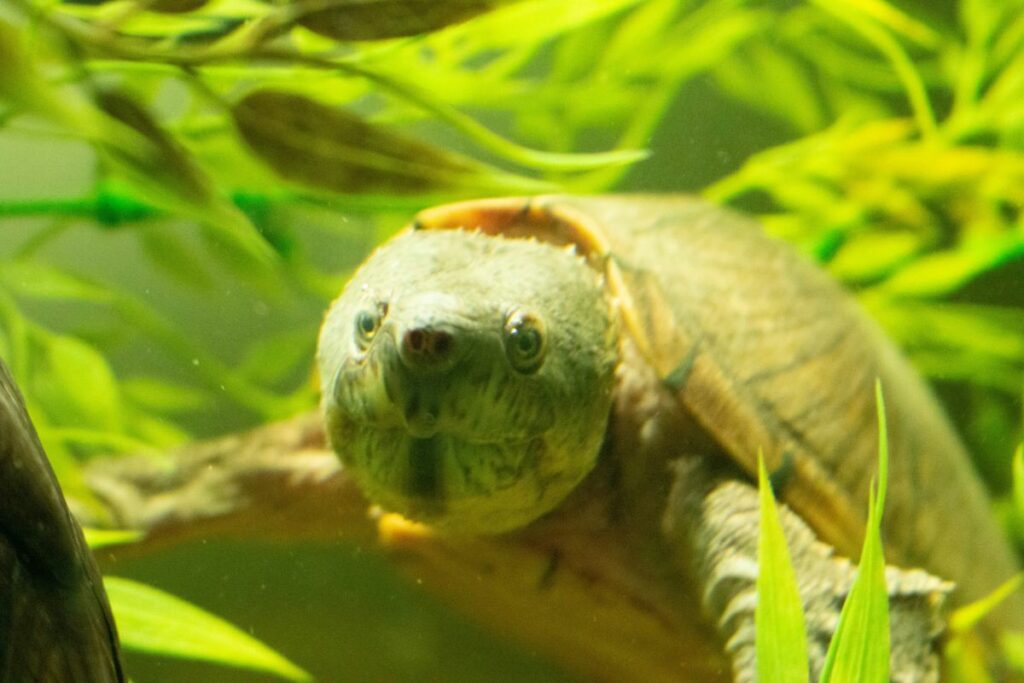
The razorback turtle has a small range. It only spans the south-central United States. They live in parts of these six states:
- Southeastern Oklahoma
- Eastern Texas
- Southern Mississippi
- Southern Arkansas
- Louisiana
- Southwestern Alabama
You’ll primarily see these turtles in freshwater habitats like rivers. They live in the Brazos River of Texas to the Pascagoula River in Mississippi. You can spot them in the Kiamichi, Red, Little, and Mountain Fork rivers in Oklahoma.
Razorback turtles prefer larger rivers and streams. Sometimes live in lakes and swamps. They also favor slow-flowing water. They prefer water bodies with sandy or rocky substrates that they use for digging. They enjoy basking, so they like areas with plenty of deadwood. They also prefer habitats with much aquatic vegetation for hiding.
Diet
The razor-backed musk turtle has long barbels hanging from its chin. The barbels enhance their sense of smell. They often use their barbels for hunting prey in the muddy substrates in the waters they inhabit.
These turtles are omnivorous and catch most of their food within the water column. A smaller turtle’s diet primarily consists of:
- Insects
- Small crustaceans
- Amphibians
- Carrion
- Aquatic plants
- Seeds.
As they get bigger, their diet seems to shift to focus more on mollusks. Asian clams are a particular favorite of this species. Asian clams make up most of the turtles’ diet, where they’re abundant. The turtles’ diet is more varied in areas where the clams are not as plentiful. Asian clams are an invasive species that damage the environment. So, razorback musk turtles do a lot of good for the ecosystem.
Behavior & Temperament
Razorback musk turtles are diurnal, which means they are active during the day and sleep at night. They are most active in the morning and late afternoon when the sun is still out but the temperature is cooler.
Turtles that live in the warmer parts of their range are active for longer lengths of the year.
These turtles are prolific baskers. They spend much more time basking than other similar species.
Underneath the water’s surface, they spend most of their time hiding. They seek out crevices, deadwood, and rocks to shelter.
Razorback musk turtles also hibernate over the winter months.
Reproduction
Since males grow larger than females, it takes longer to reach sexual maturity. Males reach sexual maturity around five to six years of age. Their carapace must have a length of 3.9-4.7 in (10-12 cm). Females become sexually mature between four to five years of age with a carapace length of 3.9 in (10 cm).
Their Bodies Prepare For Breeding
Mating takes place in the spring, around April, but may occur earlier in the warmer parts of their range.
The females display ovulatory-sized follicles between late April and early July. These larger follicles show that the female’s body is ready to produce eggs.
Males display spermatogenesis between June and August. Spermatogenesis is when sperm begins collecting inside the male’s testis.
Mating
To woo a female, a male turtle must determine if his potential mate is truly female. He approaches a potential mate and sniffs under the tail to determine the sex. Doing this is called the “tactile phase.”
Once the male determines the other turtle is a female, he moves to her side and begins nudging her with his nose.
Second, he begins the “mounting” phase, positioning himself above the female. Males have a slightly concave plastron. It allows them to mount themselves above the female’s carapace. Once mounted, he grasps the edges of her carapace with his long claws.
Third, he moves the female’s tail to the side and postures himself for mating. He stretches his head forward to reach hers and begins biting and rubbing at her head.
Researchers aren’t sure how many mates razorback turtles may have during a season. Their mating habits likely mimic that of other similar species. So, they likely mate with several turtles over the mating season.
Eggs
Nesting typically occurs between May and June. It may occur earlier in the warmer parts of their range. A female razorback turtle lays two to three clutches of eggs a season. Each clutch may contain between one to seven eggs.
The male does not provide any care for the offspring. The female creates a suitable nest to protect her eggs. Then, she leaves them to fend for themselves.
The brittle eggs are white and oval.
The eggs incubate for about 110-120 days, and they begin to hatch between August and September.
The temperature of the surrounding environment determines what sex the developing eggs become. At temperatures below 71.6°F (22°C) or above 86°F (30°C), most of the offspring become female. At about 80.6°F (27°C), most of the offspring become male.
At hatching, the juveniles have carapaces about 0.9-1.2 in (2.3-3.1 cm) long.
Predators
Eggs and juveniles are particularly prone to predation. They are tiny and unable to protect themselves. Striped skunks and raccoons frequently eat the eggs.
Common predators of hatchlings and larger juveniles include:
- Diving beetles
- Freshwater bass
- Bullfrogs
- Snakes — particularly kingsnakes & cottonmouths
- Birds of prey — particularly crows and bald eagles
Adults have far fewer predators. Yet, alligators and alligator snapping turtles often eat them.
Conservation
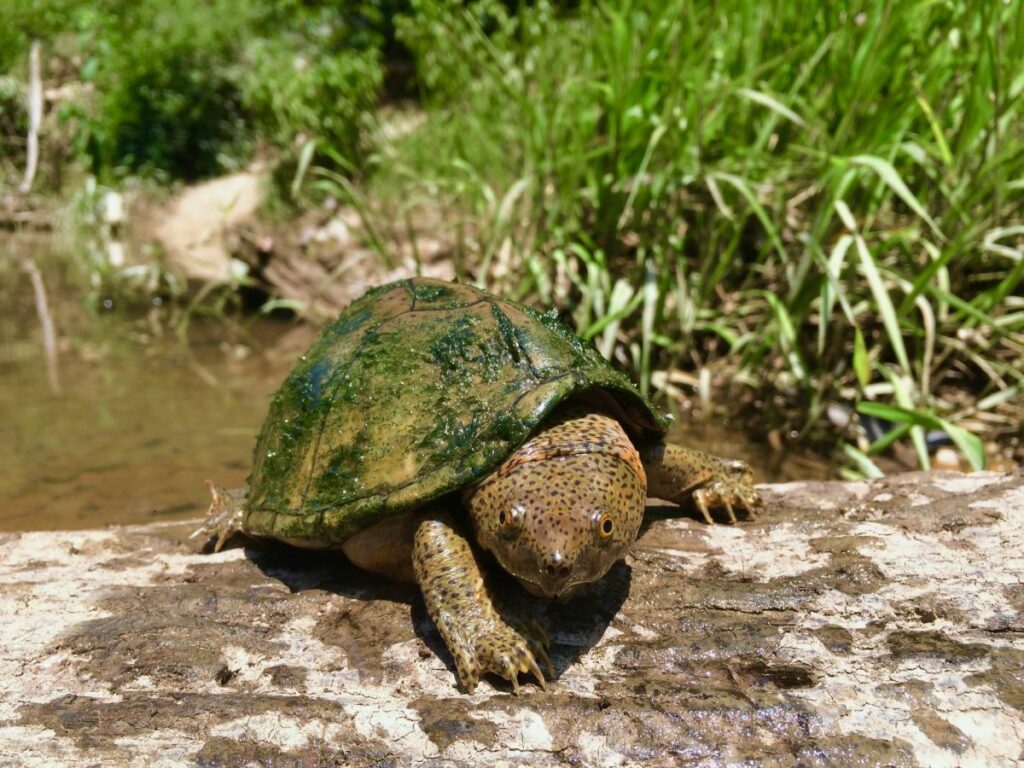
The International Union for the Conservation of Nature (IUCN) last assessed razorback musk turtles in 2011. They determined the turtles to be of “least concern” with an unknown population trend.
Razorback musk turtles play an important part in the ecosystem. They act as both predators and prey. They help to keep the populations of their prey in check. Yet, they are also an important food source for larger predators.
One of the biggest threats to these turtles is their popularity in the pet trade. The eggs and hatchlings are often taken from the wild and sold as pets. They are especially popular in Europe. Estimates show that about 50,000 wild individuals were shipped to Europe from 2008 to 2012. They are the 5th most vulnerable turtle species in the pet trade.
Habitat destruction is another concern for these turtles. Removing the deadwood they use for basking is problematic. Pollution going into the water is also ruining their habitats.
Fishing is another problem for razorback musk turtles. They are often caught on lines by mistake. Rather than releasing the turtles, fishermen often kill the turtles they catch.
Care
Razorback musk turtles are hardy animals ideal for turtle keepers of all stages. They don’t like handling, though. So, only buy one if you’re happy to sit back and watch them go about their life.
Enclosure
Adult razorback turtles are small but active. So, they’ll need a moderately-sized enclosure. Adults do well in enclosures of about 24 in (60 cm) long and 15 in (37.5 cm) wide. A 30 to 40-gallon aquarium is usually enough. Yet, most aquariums are taller than they are wide, so you may need to buy a custom aquarium.
The larger the enclosure you can provide them, the more space they’ll have to exercise. So, you can never get an enclosure too big for your turtle.
Multiple Turtles
For two turtles, you’ll need a larger enclosure, at least 36 in (90 cm) long and 18 in (45 cm) wide. For three turtles, you’ll need an enclosure at least 48 in (120 cm) long and 18 in (45 cm) wide.
Razorback musk turtles are weak swimmers. They prefer to walk along the bottom of their tank. So, they should have a shallow water depth of about 8-12 in (20.3-30.5 cm). As a general rule, you should have an extra five to ten gallons of water for each extra turtle.
A Basking Area
Most of their enclosure will comprise water, but you should provide them with a basking area. You can set up a small spot of land, or you can get a floating basking spot. There are floating turtle docks designed for basking. Or, you can set up a floating log or large rock.
Hatchlings
Hatchling razorback musk turtles are minuscule. They are barely larger than the nail on your thumb. For this reason, it’s often easier to begin with a smaller container when raising hatchlings.
It’s sometimes better to raise them in a small, 10-20 gallon aquarium where you can easily observe them. Do this for the first six to twelve months. Doing so makes it easier for you to care for them, and it’s often safer for the hatchlings.
You can always start with a larger enclosure if you don’t want to upgrade your turtle as it grows. Just ensure the water stays shallow enough not to endanger your turtle.
You should only provide them with a shallow pool of water to prevent them from drowning. A small plastic tub with about 3.9-4.7 in (10-12 cm) of water is ideal.
Inside the hatchling’s container, place a small layer of river pebbles for the turtles to walk on. Give them a floating cork board they can use for basking. Aquatic plants, like Egeria densa, also offer good hiding places for your turtles.
Unfortunately, many sellers don’t know the proper housing for these turtles. Hatchlings are often sold to go inside tropical fish tanks. Fish tanks’ depths are far too dangerous for hatchlings.
Cleaning
Turtles are dirty and will make a mess of their water. You’ll need a powerful filter to keep their water clean. You’ll want a filter equipped for an enclosure two times the size of the one you have.
For example, if you have a 50-gallon aquarium, you’ll want to buy a filter made for 100-gallon aquariums. The larger filter will better handle the amount of waste your turtle produces.
Choose a lower flow rate filter. Razorback musk turtles are not strong swimmers. You may need to buy sponges to attach to the filter to slow down the current if the flow is too much.
You’ll also need to replace the water once every week or once every two weeks. Using a gravel vacuum, remove about 25-30% of your turtle’s water and replace it with fresh water. Avoid removing more than 30% of the water except in emergencies. Changing too much of the water at once can put your turtle into shock and make them sick.
Add a dechlorinator to the new water before adding it to your tank. A dechlorinator removes harmful chlorine and heavy metals from the water.
Substrate
Substrates aren’t necessary, so you can leave the bottom of the tank bare if you prefer.
Avoid substrates like sand and pebbles that are small enough for your turtle to eat. Your turtle may swallow the substrate, which can cause impaction.
Still, substrates can make your tank look more natural. Here are some safe substrates to use:
- Flat rocks
- Large river pebbles
Decorations
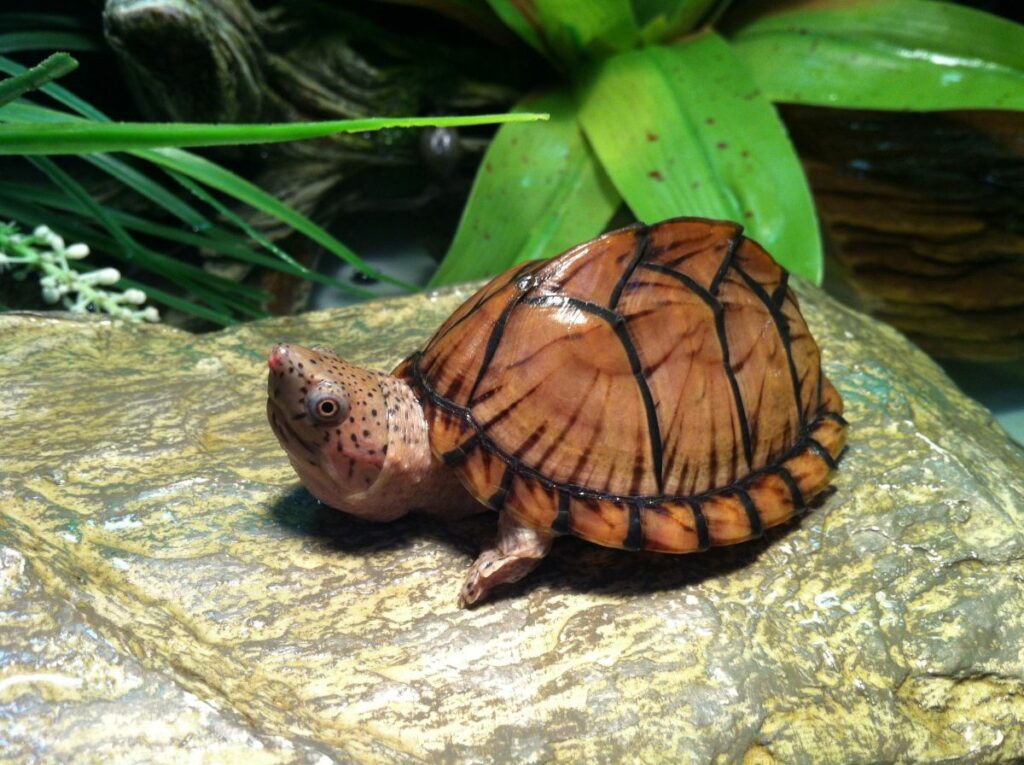
Provide your turtle with plenty of decorations they can explore and use for hiding. Driftwood or bogwood is an excellent option, along with rocks they can use for climbing.
Live aquatic vegetation is also ideal for hiding. They provide your turtle with live, fresh food, and they help to keep the water healthy.
Silk plants are an excellent alternative to live plants if you don’t want to care for vegetation. They provide your turtle with a place to hide and make its enclosure look nicer. Silk plants are better than hard, plastic plants that can scrape your turtle’s shell and skin.
Temperature & Lighting
Razorback turtles are native to North America, which has temperate weather. So, you may not need a water heater if your house stays warm enough. Water temperatures should be between 73.4-77°F (23-25°C).
You may need a low-wattage water heater if your house does not stay warm enough.
Your turtles will also need a heating lamp and a UVB bulb. These help your turtle regulate body temperature. They also keep their shells and bones healthy.
UVB bulbs are essential for your turtle’s health. They allow your turtle’s body to produce enough vitamin D3. Without a UVB bulb, your turtle will develop metabolic bone disease (MBD). MBD is a painful and sometimes fatal disease that pet turtles are prone to.
Bear in mind that UVB bulbs lose their effectiveness after about six months, so you’ll need to replace them.
You’ll want to mimic a day-night cycle for your turtle. So, keep the light on for 12 hours and off for another 12 hours. It’s easiest to buy a timer that can turn the light on and off for you, so you don’t forget.
The basking area will be the hottest part of the enclosure, with temperatures between 85-90°F (29.5-32°C).
The ambient temperature of your turtle’s tank should be between 75-82°F (24-28°C).
Tank Mates
Razorback musk turtles aren’t social, so they don’t need tank mates and will be happy alone. Yet, if you’d like more than one turtle, it’s possible to house multiple together as long as you have enough space.
Never keep more than one male in your tank. Males become territorial around each other. So, your turtles will be likely to fight and get injured.
Handling
Like most turtles, razorback musk turtles don’t enjoy handling. Still, they will tolerate occasional gentle handling. Still, you should limit handling to when it’s absolutely necessary.
As long as you are gentle with your turtle, you needn’t worry about it “musking” you. They only release their glands when they’re feeling terrified and threatened. Most musk turtle owners never get musked by their pets.
Some owners prefer to feed their turtles in separate containers. They are messy eaters, so this reduces the mess in their home tank. It’s okay to do this, but move slowly and be gentle when transferring your turtle.
Diet
Razorback musk turtles are far more carnivorous in captivity than in the wild.
Healthy, vitamin-rich pellets should comprise a large part of your turtle’s diet. The pellets usually contain most of the proteins and vitamins your turtle needs.
It can be hard to transition wild-caught turtles to a pellet diet, so be patient. Provide them with more fresh food in the meantime.
Hatchlings need to eat more than adults, so you should feed them daily. Due to their tiny size, you should chop up their food to avoid choking. You can feed adults every other day.
Here are some meaty foods that are safe to provide your turtle:
- Bloodworms
- Mealworms
- Earthworms
- Small crickets
- Small dubia roaches
- Krill
- Chopped mussels
- Chopped trout
- Chopped salmon
- Aquatic snails
- Black soldier fly larvae
- Feeder guppies
Here is some vegetation that is safe to provide your turtle:
- Duckweed
- Egeria densa
- Kale
- Collard greens
- Mustard greens
- Lettuce
- Spinach
- Cabbage
- Celery
- Watercress
Razorback turtles are prone to get hooked on certain foods if you give them too often. Make sure you rotate their diet and give them plenty of variety to avoid this. You don’t want your turtles to become too picky in case their favorite food becomes unavailable.
Place food at different locations around the tank if you have more than one turtle. Placing food in only one spot is likely to cause fighting. The smaller, more docile tank mates may not get as much food as they need.
Supplements
Captive turtles often do not receive the necessary nutrients to stay healthy. Before feeding, dust their food with a calcium supplement. Calcium keeps their bones and shells healthy. You can also dust their food with an occasional multivitamin supplement.
Health Problems
Razorback musk turtles are hardy and rarely have health issues. Still, here are some conditions to watch out for:
Metabolic Bone Disease (MBD) occurs when a turtle isn’t getting enough sunlight or calcium. Their body cannot produce vitamin D3, and they can’t absorb calcium. As a result, their bones do not develop normally and form abnormalities.
MDB is usually treatable, although results are better the sooner you spot problems. MBD can be fatal if your turtle goes without treatment long enough.
Here are the symptoms to look out for in MBD:
- Irregular bumps on the skin
- Pyramiding of the shell or skin
- Eye irritation
- Sores
Respiratory infections are also common in turtles. Infections occur in enclosures with low temperatures. Ensure your turtle’s tank is always warm enough to keep its immune system healthy.
Here are symptoms to look out for in respiratory infections:
- Lethargy
- Mucus from the nose
- Watery eyes
- Decreased appetite
Skin infections are common in turtles housed with territorial turtles. They can also occur if there are decorations that are too sharp. The turtles experience cuts and injuries on their skin and shells. Without treatment, injuries can become infected.
Here are the symptoms to look out for in skin and shell infections:
- Cut or scratches
- Red skin
- Swelling
Razorback Musk Turtle Care, In A Nutshell
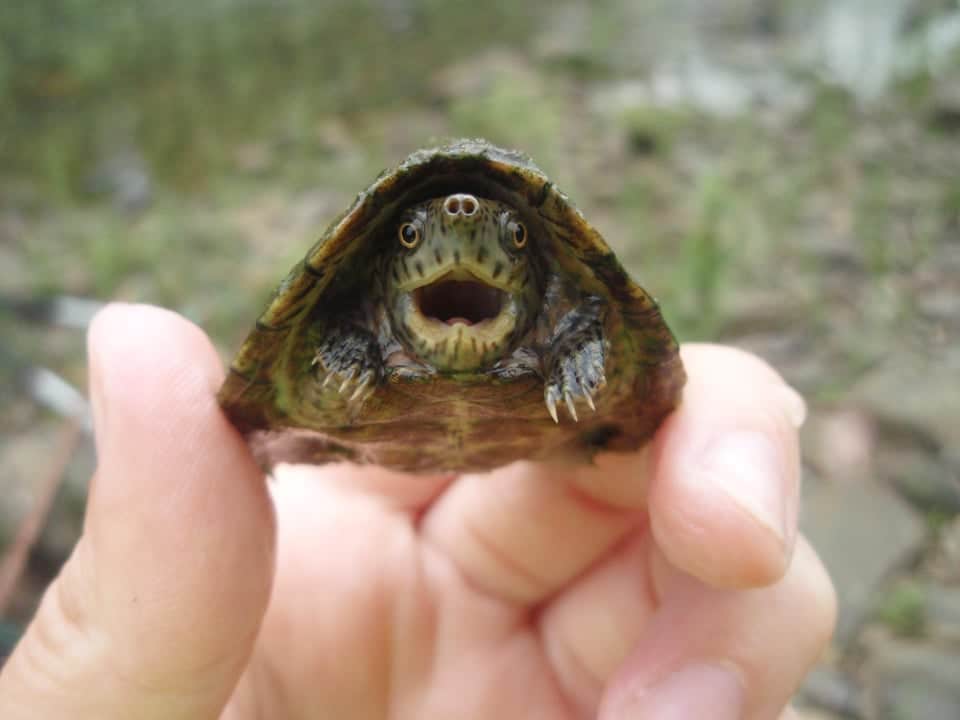
Consult this razorback musk turtle care sheet for quick care tips:
| Razorback Musk Turtle Care | |
| Enclosure Size | 30-40+ gallons OR24 in (60 cm) long and 15 in (37.5 cm) wide |
| Temperature | Daytime Temperature — 75-82°F (24-28°C)Basking Temperature — 85-90°F (29.5-32°C)Water Temperature — 73.4-77°F (23-25°C) |
| Lighting | UVB Daytime BulbHeat Lamp |
| Decorations | Hollow LogsCavesVegetationDriftwood/Bogwood |
| Tank Mates | Alone or in Small Groups — One Male per Group |
| Diet | Various High-Calcium Proteins and Vegetables |
| Handling | Minimal to No Handling |
FAQs
Razorback musk turtles are poor swimmers who don’t like deep water. Instead, they prefer water that’s only a few inches deep. They spend most of their time walking along the floor of a water body rather than swimming through it.
Razorback musk turtles are in the moderate price range. Most razorbacks cost over $80, but they rarely cost more than $200.
It’s best to meet your turtle before deciding to take them home. Doing so allows you to meet with the breeder and assess your turtle’s health. You can also buy from online breeders if none are local to you. Make sure to thoroughly research breeders before buying their turtles. Doing so ensures you’re getting a healthy turtle from a reputable breeder.
Razorback musk turtles are not usually aggressive with each other. Many turtle owners keep many in the same tank. They are fearful and might bite if they feel threatened, though it’s rare. They’re also equipped with glands that can release a foul-smelling substance. They release their glands when they feel threatened. Again, it’s rare that turtle keepers are “musked” by their turtles.
